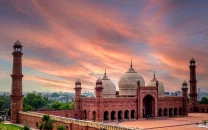Small is big now: Why Sukkur is way cooler than Karachi
Consultants, ADB envision residential complexes in Larkana, twin cities of Sukkur-Rohri.

Architect and urban planner Masood Jafri spoke of how his firm had mapped Larkana.
Conventional wisdom gauges the scale of economic development with the growth of megacities. However, some urban planners beg to differ.
Their new approach is the strategic planning and sustainable development of secondary or smaller cities. Therefore, believe it or not, the growth of Sukkur and Larkana can “provide an impetus to urban and rural development as they have characteristics of urban areas and have proximity to rural settlements”. Karachi is not their focus.
The growth of secondary cities will increase urban income via investments and it will swell rural income through remittances. Architect and urban planner Masood Jafri explained how “rationalised and prioritised planning for smaller cities” can play an extremely important role in economic growth and sustainable development.
At the urban and policy planning session on the first day of the South Asian Cities Conference on Friday, Jafri gave a presentation on what his consultancy firm had envisioned for Larkana. His team documented the radial pattern of the city’s development and divided it into three zones. The northwest part of the city is the most recently developed area. Apart from concentrating on residential and housing in the northwest area - labelled Zone 3 - Jafri presses for more government land and municipal offices.

Why? Because the state of the local government was a major weakness in the city’s development. Asian Development Bank’s (ADB) Allan Kelly explained how the financial sustainability of local governments is key. “When we return 10 to 20 years after building government institutions, we see they have degraded,” he solemnly said. The decentralisation of power is great but we need to ensure that the government can meet the demands of the people and deliver, which they cannot do without a constant flow of funds.

The red area marks the old city of Larkana and the zones mark the new and radial development
This is all part of the ADB’s new approach - the urban policy planners realised that, for too long, they had been concentrating on sub-sector development, devoid of an integrated-planning approach, explained Kelly.
With a new lens, the ADB is concentrating on and supporting analytical estimates and mapping integrated plans for secondary cities, with the inclusiveness of the population.
Urban planner and consultant Mubushar Hussain, too, presented an integrated city master plan, but for Sukkur. The city has 60% planned area, which is inhabited by only 30% of the population. But Hussain pitched a simple strategy to curb the disorganised growth: renew katchi abadis with smart and vertical development. He called for more direction and opportunity for the local governments as well as the population via educational institutes, recreation areas and municipal authorities. “There is no public sector university in Sukkur and open spaces make up only 1.5% of the built-up area.” According to international standards, it should comprise 5% to 7.5% of the planned area.

Moreover, Hussain highlighted the twin-city potential of Sukkur and Rohri, with industrial zones, and utilising its strategic location of being bordered by the River Indus. He described his vision of the two cities: “a sustainable, safe and sound trading hub with a healthy environment, comfortable living and economic opportunities for residents, visitors and tourists.” He added visitors and tourists because the development of the cities and its location can attract people for work and tourism from Punjab and Sindh, increasing urban and rural revenue.
Concluding the session, the panellists commended the urban planning strategies of the two cities, but Dr Jagath Munasinghe, the head of Sri Lanka’s Department of Town and Country Planning, asked what multiple city plans had been submitted in the past and what happened to them. Masoof Jafri replied that none of the cities’ master plans have legal cover and the municipal authorities are not bound to follow them. “Our master plans are unfortunately reduced to paper practice.”
Published in The Express Tribune, January 11th, 2014.





1675249047-0/image-(18)1675249047-0-208x130.webp)













COMMENTS
Comments are moderated and generally will be posted if they are on-topic and not abusive.
For more information, please see our Comments FAQ